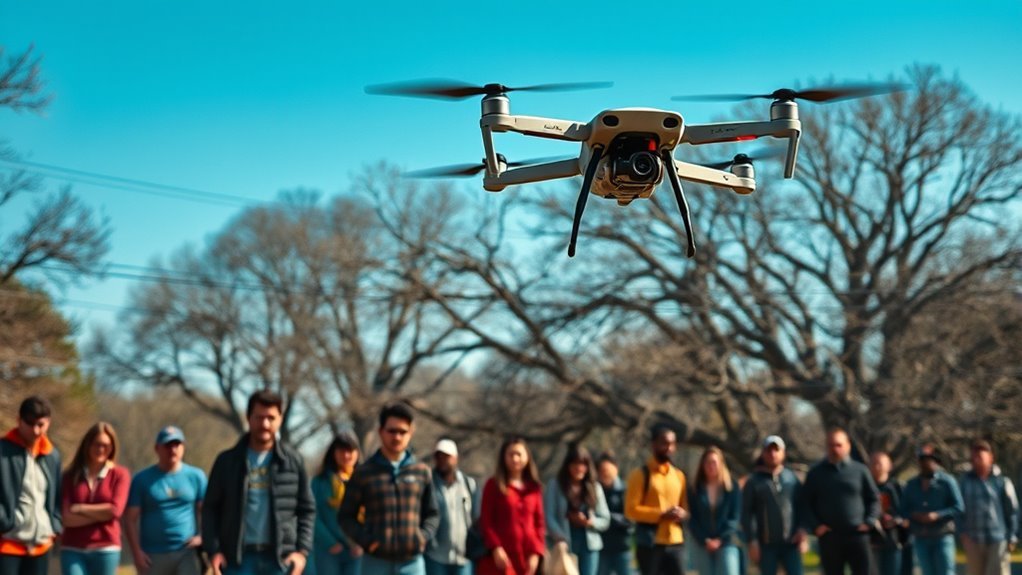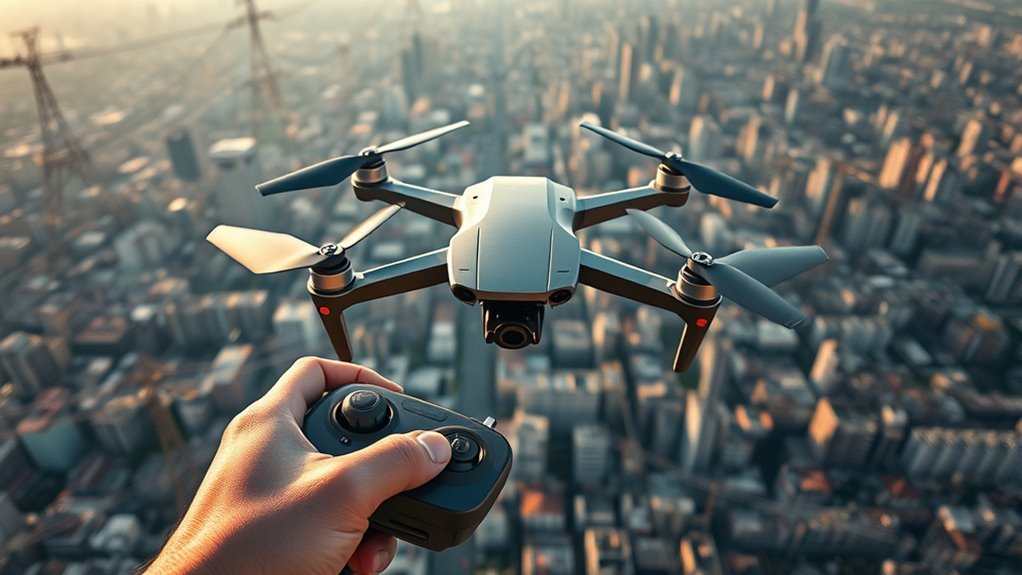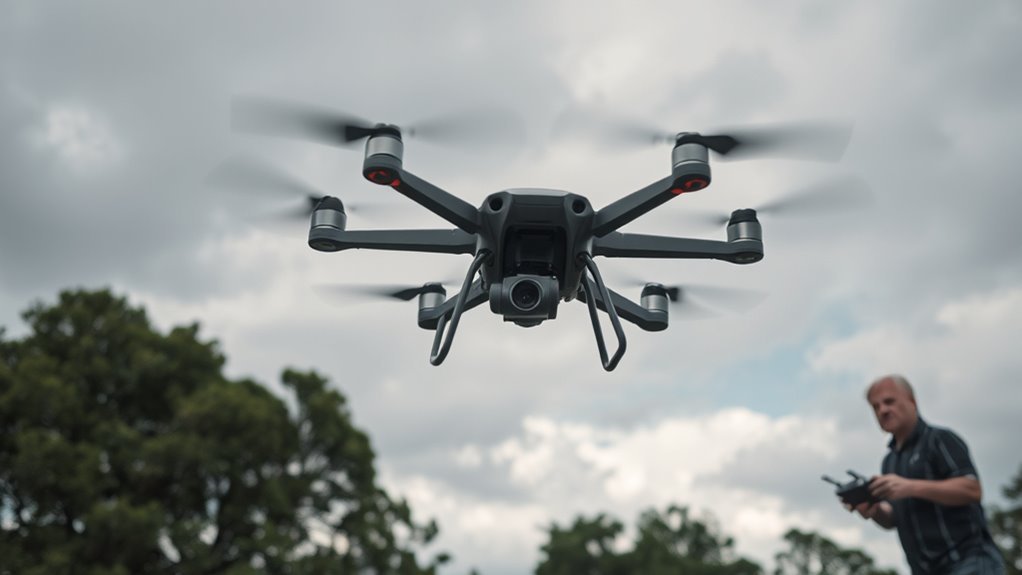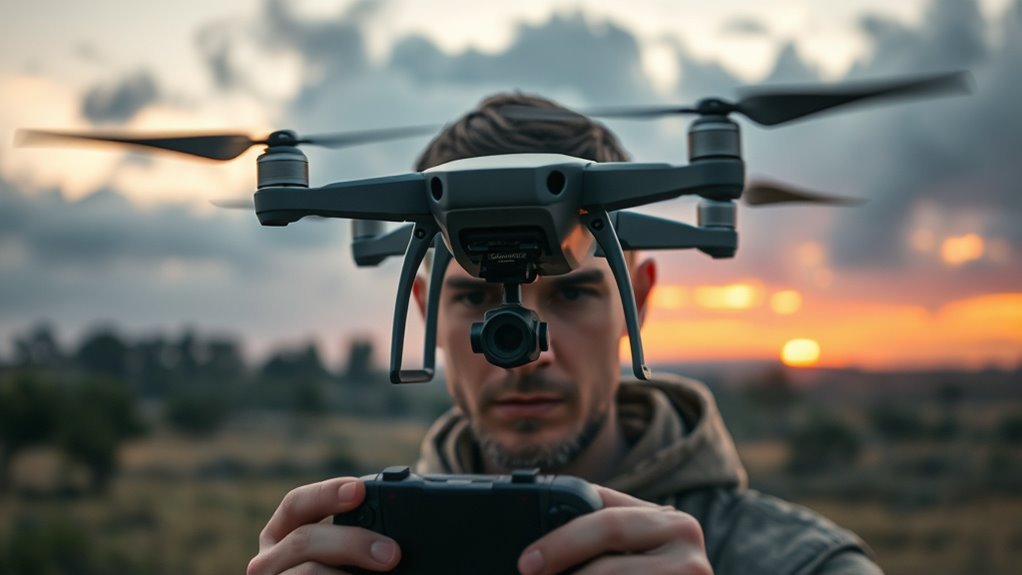Flying a drone is hard due to the complex interaction of mechanical components, control systems, and environmental factors. You must navigate intricate regulations while managing battery life and ensuring stable flight in varying weather conditions. Technical glitches, like GPS signal loss or camera failure, can disrupt your operation. Additionally, spatial awareness and understanding safety and privacy concerns add layers of challenge. There’s much more to discover about mastering these challenges and enhancing your flying skills.
Understanding Drone Mechanics

Understanding the mechanics of a drone is essential for mastering its operation. You need to grasp the intricate relationship between drone components, such as motors, propellers, and flight controllers, to guarantee smooth flight dynamics. Each component plays a critical role; for instance, the motors generate thrust while the flight controller stabilizes the craft. You’ll find that understanding how these elements interact affects your ability to maneuver effectively. Flight dynamics encompass how your drone responds to inputs, including pitch, roll, and yaw. By analyzing these interactions, you can predict its behavior in various conditions. A solid comprehension of these mechanics not only enhances your piloting skills but also empowers you to push the boundaries of your drone’s capabilities, giving you the freedom to explore. Additionally, understanding camera sensor size can significantly impact the quality of your aerial footage, especially in low-light conditions. Drones like the DJI Mini 3 Pro offer advanced imaging technologies that enhance your aerial photography experience.
Navigating Flight Regulations

Mastering drone mechanics lays a solid foundation, but operating a drone also demands a keen awareness of flight regulations. Managing the complexities of regulatory compliance and legal restrictions isn’t just a formality; it’s essential for responsible flying. Here’s a quick overview of regulations you should consider:
| Regulation Type | Description |
|---|---|
| FAA Regulations | Federal rules governing airspace use |
| Local Ordinances | Specific rules for your flying area |
| No-Fly Zones | Areas where flying is prohibited |
| Registration | Requirement to register drones > 0.55 lbs |
| Privacy Laws | Rules related to capturing images/videos |
Understanding these regulations empowers you to fly freely while respecting the laws that keep everyone safe. Moreover, knowing about federal laws governing drone operation can help you navigate the intricacies of airspace regulations. Stay informed to avoid potential pitfalls.
Mastering Control Systems

While flying a drone can be exhilarating, mastering control systems is essential for achieving stability and precision in flight. You’ll need to understand control algorithms that govern how your drone responds to input commands. These algorithms help maintain balance, especially during maneuvers or in response to external forces. Signal interference from obstacles or electronic devices can disrupt communication with your drone, leading to erratic behaviors. To combat this, you’ll want to guarantee that your control systems are robust enough to filter out noise and maintain a steady connection. By honing your skills in these areas, you’ll reveal the true potential of your drone, allowing you to explore the skies freely and confidently. Advanced stabilization technology is key to becoming a proficient pilot, as it enhances user confidence during flight. Additionally, knowing how to manage battery performance effectively will ensure that your drone remains operational for extended missions. Mastering these concepts is key to becoming a proficient pilot.
Adapting to Weather Conditions
When flying a drone, you’ll quickly realize that weather conditions greatly impact its performance. Wind resistance can destabilize your flight path, making precise control challenging, while rain can reduce visibility and affect the drone’s electronic systems. Understanding these factors is essential for safe and effective operation. Additionally, environmental conditions such as low temperatures can degrade battery efficiency, limiting your flight time in cold weather.
Wind Resistance Challenges
Although flying a drone can be an exhilarating experience, adapting to wind resistance poses significant challenges that require careful consideration. You’ll need to understand wind shear effects, as sudden changes in wind speed and direction can dramatically alter your drone’s trajectory. These shifts can lead to instability, making control difficult. Moreover, turbulence impact can create unexpected movements, requiring quick adjustments to maintain steady flight. This unpredictability demands a heightened awareness of weather conditions and the ability to adapt your flying technique accordingly. By mastering these challenges, you not only enhance your piloting skills but also expand your freedom to explore diverse environments without compromising safety. Recognizing and responding to wind resistance is essential for achieving a successful flight experience.
Rain and Visibility Issues
Wind resistance isn’t the only environmental factor that complicates drone flight; rain and reduced visibility present their own set of challenges. When rain falls, it can create significant rain effects that impact your drone’s performance. Water can obstruct sensors, interfere with the camera, and increase weight, leading to decreased maneuverability. Additionally, visibility limitations in rainy conditions can make it difficult to maintain line-of-sight, which is vital for safe operation. You may find it tough to gauge altitude and distance accurately, heightening the risk of collisions. Adapting to these weather conditions requires skill and awareness. Always check weather forecasts and be prepared to alter your flight plans to guarantee safety and maximize the freedom you seek while flying your drone.
Handling Battery Life and Management
While mastering drone operation involves various challenges, effectively managing battery life is essential for maximizing flight time and performance. You need to focus on battery optimization and power management strategies to guarantee your drone operates efficiently. Start by monitoring your battery’s charge levels and understanding its discharge rates during different flight conditions. Using features like smart mode and efficient routing can greatly enhance battery longevity. Additionally, avoid abrupt maneuvers that drain power quickly. Regularly calibrating your battery and adhering to recommended charge cycles will prolong its lifespan. By implementing these techniques, you’re not only extending your flight time but also enhancing overall drone reliability, giving you the freedom to explore further and capture stunning visuals without the constant worry of battery depletion. Moreover, understanding the differences in battery capacity between models like the Lucid Cleaning Drone and Autel EVO Lite V2 can help you make informed choices for your specific needs. Additionally, utilizing a three-axis gimbal can help maintain stability during dynamic movements, further optimizing your drone’s performance and battery efficiency.
Overcoming Technical Glitches
When flying a drone, you’re likely to encounter common malfunctions that can disrupt your operation. Understanding effective troubleshooting techniques is essential for quickly resolving issues and ensuring safety. By familiarizing yourself with these challenges and solutions, you can enhance your flying experience and maintain control over your drone. Additionally, being aware of your drone’s battery performance can help you prevent unexpected interruptions during flight. Moreover, leveraging real-time data collection can significantly enhance your ability to monitor environmental conditions and respond swiftly to any technical issues.
Common Drone Malfunctions
Although drone technology has advanced considerably, operators often encounter common malfunctions that can disrupt flight operations. These issues may stem from outdated drone software, improper sensor calibration, or hardware failures. Recognizing these malfunctions early can enhance your flying experience and safety.
| Malfunction | Cause | Solution |
|---|---|---|
| GPS Signal Loss | Interference or blockage | Maintain clear line of sight |
| Battery Drain | Overuse or aging battery | Regularly check battery health |
| Camera Failure | Software glitch or damage | Update firmware and inspect |
Troubleshooting Techniques Explained
To effectively troubleshoot technical glitches that can arise during drone operation, you need to adopt a systematic approach. Begin by consulting your troubleshooting checklist, which should include steps for evaluating battery levels, firmware updates, and propeller condition. If you experience erratic flight patterns, signal interference might be the culprit; check for potential sources like Wi-Fi routers or other electronic devices nearby. Ascertain your drone’s antennas are unobstructed and properly oriented. If issues persist, recalibrating the compass and gyroscope can often resolve navigation inaccuracies. Finally, logging your experiences can help identify recurring problems, allowing for preemptive measures in future flights. By following these techniques, you’ll enhance your flying experience and maintain your drone’s performance.
Developing Spatial Awareness
Developing spatial awareness is essential for effective drone piloting, as it enables you to comprehend the drone’s position relative to its surroundings. This involves honing your spatial orientation and depth perception, which are vital for maneuvering through complex environments. You’ll need to visualize the drone’s trajectory in three-dimensional space while considering obstacles and changes in elevation. Practicing in varied conditions will enhance your ability to judge distances and angles, allowing for smoother flights and safer landings. Utilizing first-person view (FPV) can further improve your spatial awareness, as it provides a real-time perspective of the drone’s surroundings. Ultimately, mastering these skills grants you the freedom to explore and navigate effectively, making your flying experience both enjoyable and efficient.
Learning Photography and Videography Skills
Mastering spatial awareness isn’t just about steering your drone; it also lays the groundwork for capturing stunning imagery and video. To enhance your photography and videography skills, you should focus on three essential elements:
- Composition Techniques: Understand the rule of thirds and framing to create visually appealing shots.
- Lighting Adjustments: Experiment with the golden hour and adjust your camera settings for ideal exposure to highlight details.
- Angle Selection: Explore various perspectives, from low angles to bird’s-eye views, to add depth and drama to your footage. Additionally, experimenting with advanced features and intelligent flight modes can help you capture dynamic shots effortlessly.
Managing Safety and Privacy Concerns
While flying a drone can be an exhilarating experience, maneuvering the complex landscape of safety and privacy concerns is vital to secure responsible operation. You must adhere to established safety protocols, such as maintaining visual line-of-sight and avoiding restricted airspace. Understanding and complying with privacy regulations is equally critical; these laws protect individuals’ rights and dictate where you can legally operate. Additionally, many drone brands are now implementing geo-fencing technology to help ensure that operators do not inadvertently enter restricted areas. Failing to navigate these requirements can lead to legal repercussions and compromise public trust in drone technology. By prioritizing safety and respecting privacy, you not only enhance your flying experience but also contribute to a culture of responsible drone use. Obtaining consent from homeowners when flying over private land ensures that you can enjoy the skies while safeguarding the interests of those around you. Balancing freedom with accountability guarantees that you can enjoy the skies while safeguarding the interests of those around you.
Frequently Asked Questions
What Are Common Mistakes Beginners Make When Flying Drones?
When flying drones, common errors include improper calibration and neglecting battery life. Mastering flight techniques like smooth controls and awareness of surroundings can enhance your experience, ensuring more freedom and fewer mishaps in the skies.
How Can I Improve My Drone Flying Skills Quickly?
To enhance your drone flying skills quickly, consider that 70% of beginners benefit from using drone accessories like advanced controllers. Focus on mastering essential flight techniques, and practice regularly to build confidence and precision in your maneuvers.
Are Drone Simulators Helpful for Learning to Fly?
Drone simulators can greatly enhance your flying skills by allowing you to practice flight physics and drone technology in a controlled environment, helping you grasp essential concepts without the risks associated with real-world flying.
What Are the Best Drones for Beginners?
When considering the best beginner drones, look for top features like stability, ease of control, and built-in safety measures. Models like the DJI Mini SE or Holy Stone HS720 offer excellent user-friendly experiences for novice pilots.
How Much Practice Is Needed to Fly a Drone Proficiently?
Studies show it takes about 20 hours of practice to achieve proficiency. You’ll need consistent practice frequency and regular skill assessments to refine your techniques, ensuring you’re ready to explore the skies with confidence and freedom.

